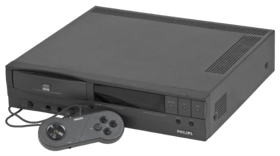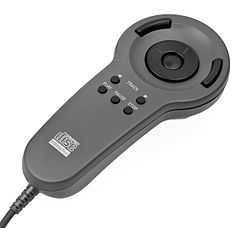Philips CD-i
|
| |
 The Philips CD-i 910 and controller | |
| Manufacturer |
Philips Electronics Sony Magnavox |
|---|---|
| Type |
Video game console Media player |
| Generation | Fourth generation |
| Retail availability | |
| Discontinued | 1998[1] |
| Units sold | 1 Million[2][3] |
| Media | CD-i, Audio CD, CD+G, Karaoke CD, VCD |
| CPU | Philips SCC68070 |
| Graphics | Philips SCC66470 |
| Best-selling game | Zelda's Adventure |
The Philips CD-i (Compact Disc Interactive) is an interactive multimedia CD player developed and marketed by Royal Philips Electronics N.V. This category of device was created to provide more functionality than an audio CD player or game console, but at a lower price than a personal computer with a CD-ROM drive at the time. The cost savings were due to the lack of a hard drive, floppy drive, keyboard, mouse, monitor (a standard television was used), and less operating system software.
In addition to games, educational and multimedia reference titles were produced, such as interactive encyclopedias, museum tours, etc., which were popular before public Internet access was widespread. Competitors included the Tandy VIS and Commodore CDTV.
CD-i also refers to the multimedia Compact Disc standard used by the CD-i console, also known as Green Book, which was developed by Philips and Sony (not to be confused with MMCD, the pre-DVD format also co-developed by Philips and Sony). Work on the CD-i began in 1984 and it was first publicly announced in 1986.[4] The first Philips CD-i player, released in 1991 and initially priced around USD $700,[5] is capable of playing interactive CD-i discs, Audio CDs, CD+G (CD+Graphics), Karaoke CDs, and Video CDs (VCDs), though the latter requires an optional "Digital Video Card" to provide MPEG-1 decoding.
Seen as a game console, the CD-i format proved to be a commercial failure,[1] and several of its games are considered among the worst ever made. However, the device was sold until 1998, despite claims that Phillips planned a discontinuation in 1996 and them losing nearly one billion dollars on the entire project.
The CD-i was also the first console to feature modernized online gaming features that we still use today, including subscriptions, web browsing, downloading, e-mail, and cross-country online play.[6]
Applications
Early software releases in the CD-i format focused heavily on educational, music, and self-improvement titles, with only a handful of video games, many of them adaptations of board games such as Connect Four. Later attempts to develop a foothold in the games market were rendered irrelevant by the arrival of cheaper and more powerful consoles, such as the Nintendo 64 and PlayStation. Earlier CD-i games included entries in popular Nintendo franchises, although those games were not developed by Nintendo. Specifically, a Mario game (titled Hotel Mario), and three Legend of Zelda games were released: Link: The Faces of Evil, Zelda: The Wand of Gamelon and Zelda's Adventure. Nintendo and Philips had established an agreement to co-develop a CD-ROM enhancement for the Super Nintendo Entertainment System due to licensing disagreements with Nintendo's previous partner Sony (an agreement that produced a prototype console called the Play Station). While Philips and Nintendo never released such a CD-ROM add-on, Philips was still contractually allowed to continue using Nintendo characters.
Applications were developed using authoring software produced by OptImage. This included OptImage's Balboa Runtime Libraries and MediaMogul. The second company that produced authoring software was Script Systems; they produced ABCD-I.
Philips also released several versions of popular TV game shows for the CD-i, including versions of Jeopardy! (hosted by Alex Trebek), Name That Tune (hosted by Bob Goen), and two versions of The Joker's Wild (one for adults hosted by Wink Martindale and one for kids hosted by Marc Summers). All CD-i games in North America (with the exception of Name That Tune) had Charlie O'Donnell as announcer. The Netherlands also released its version of Lingo on the CD-i in 1994.
In 1993, American musician Todd Rundgren created the first music-only fully interactive CD, No World Order, for the CD-i. This application allows the user to completely arrange the whole album in their own personal way with over 15,000 points of customization.
CD-i has a series of learning games ("edutainment") targeted at children from infancy to adolescence. Those intended for a younger audience included Busytown, The Berenstain Bears, and various others which usually had vivid cartoon-like settings accompanied by music and logic puzzles.
Although extensively marketed by Philips, notably via infomercial, consumer interest in CD-i titles remained low. By 1994, sales of CD-i systems had begun to slow, and in 1998 the product line was dropped.
A large number of full motion video titles such as Dragon's Lair and Mad Dog McCree appeared on the system. One of these, Burn:Cycle, is considered one of the stronger CD-i titles and was later ported to PC.
With the home market exhausted, Philips tried with some success to position the technology as a solution for kiosk applications and industrial multimedia. The console still maintains a cult following on the Internet.[citation needed]
Player models
Philips models


In addition to consumer models, professional and development players were sold by Philips Interactive Media Systems and their VARs. Philips marketed several CD-i player models.
- The CD-i player 200 series, which includes the 205, 210, and 220 models. Models in the 200 series are designed for general consumption, and were available at major home electronics outlets around the world. The Philips CD-i 910 is the American version of the CD-i 205, the most basic model in the series.
- The CD-i player 300 series, which includes the 310, 350, 360, and 370 models. The 300 series consists of portable players designed for the professional market and not available to home consumers. A popular use was multimedia sales presentations such as those used by pharmaceutical companies to provide product information to physicians, as the devices could be easily transported by sales representatives.
- The CD-i player 400 series, which includes the 450, 470, 490 models. The 400 models are slimmed-down units aimed at console and educational markets. The CD-i 450 player, for instance, is a budget model designed to compete with game consoles. In this version, an infrared remote controller is not standard but optional.
- The CD-i player 600 series, which includes the 601, 602, 604, 605, 615, 660, and 670 models. The 600 series is designed for professional applications and software development. Units in this line generally include support for floppy disk drives, keyboards and other computer peripherals. Some models can also be connected to an emulator and have software testing and debugging features.
There also exist a number of hard-to-categorize models, such as the FW380i, an integrated mini-stereo and CD-i player; the 21TCDi30, a television with a built-in CD-i device; and the CD-i 180/181/182 modular system, the first CD-i system produced.
Other manufacturers
Besides Philips, several other manufacturers produced CD-i players, including Magnavox, GoldStar / LG Electronics, Digital Video Systems, Memorex, Grundig, Sony ('Intelligent Discman', a portable CD-i player), Kyocera, NBS, Highscreen, and Bang & Olufsen, who produced a television with a built-in CD-i device (Beocenter AV5).
TeleCD-i and CD-MATICS
Recognizing the growing need among marketers for networked multimedia, Philips partnered in 1992 with Amsterdam based CDMATICS to develop TeleCD-i (also TeleCD). In this concept, the CD-i player is connected to a network (PSTN, Internet or other) enabling data-communication and rich media presentation. Dutch grocery chain Albert Heijn and mail-order giant Neckermann Shopping were early adopters and introduced award-winning TeleCD-i applications for their home-shopping and home-delivery services. CDMATICS also developed the special Philips TeleCD-i Assistant and a set of software tools helping the worldwide multimedia industry to develop and implement TeleCD-i. TeleCD-i was the world's first networked multimedia application at the time of its introduction. In 1996, Philips acquired source code rights from CDMATICS.
Technical specifications


CPU
Display
- Graphics Chip: SCC66470, later MCD 212[7]
- Resolution: 384×280 to 768×560
- Colors: 16.7 million w/ 32,768 on screen
- MPEG 1 Cartridge Plug-In for VideoCD and Digital Video
Audio
Operating System
Other
- 1 MB of main RAM[7]
- Single speed CD-ROM drive
- Weight with DV cart 1.460 kg, without DV 1.210 kg
CD-i accessories
- CD-i mouse
- Roller controller
- CD-i trackball
- I/O port splitter
- Touchpad controller
- Gamepad controller (Gravis PC GamePad)
- IR wireless controller
- S-video cable
- RAM expansion and Video-CD (MPEG-1) support with DV Cart
Market competition
Interactive Kiosk (primary market)
High-end A/V (secondary market)
(multi-purpose audio/video systems)
Video game (secondary market)
- Sega Mega Drive/Genesis with Sega Mega-CD/Sega CD CD-ROM expansion
- 3DO Interactive Multiplayer
- Commodore CDTV
Reception
The CD-i was met (after its discontinuation) with overwhelmingly negative reviews that criticized its price, graphics, games and controls. In fact, the CD-i's various controllers were ranked the fifth worst video game controller by IGN editor Craig Harris.[9] PC World (magazine) ranked it as fourth on their list of The 10 Worst Video Game Systems of All Time. [10] Gamepro.com also listed the game as number four on their list of The 10 Worst-Selling Consoles of All Time. [11] In 2008, CNET also listed the system on its list of The worst game console(s) ever. [12] In 2007, GameTrailers ranked the Philips CD-i as the fourth worst console of all time in its Top 10 Worst Console lineup.[13]
Games that were most heavily criticized include Hotel Mario, Link: The Faces of Evil, Zelda: The Wand of Gamelon and Zelda's Adventure. EGM's Seanbaby rated The Wand of Gamelon as one of the worst games of all time.[14]
However many games were praised. Among them, Burn:Cycle,[15][16] Chaos Control,[17][18] Mutant Rampage: Bodyslam,[19][20] and an advanced visual version of Tetris.[21]
See also
- CD-i Ready
- CDTV - Commodore's short lived equivalent system.
References
- ↑ 1.0 1.1 1.2 Blake Snow (2007-05-04). "The 10 Worst-Selling Consoles of All Time". GamePro.com. Archived from the original on 2007-05-08. Retrieved 2007-11-25.
- ↑ http://news.google.com/newspapers?id=fvAjAAAAIBAJ&sjid=MO0DAAAAIBAJ&pg=6925,7664744&dq=philips+cd-i+owners+worldwide&hl=en
- ↑ http://news.google.com/newspapers?id=IqMaAAAAIBAJ&sjid=Ii0EAAAAIBAJ&pg=6614,7897814&dq=philips+cd-i+1+million&hl=en
- ↑ (2005). History of the Philips CD-i, Philipscdi.com.
- ↑ "COMPANY NEWS; New Philips CD - The New York Times". Nytimes.com. 1992-04-02. Retrieved 2009-08-19.
- ↑ http://cdii.blogspot.com/2007/06/daves-place-cd-is-way-to-meet-with.html
- ↑ 7.0 7.1 7.2 7.3 Forster, Winnie (2005). The encyclopedia of consoles, handhelds & home computers 1972 - 2005. GAMEPLAN. p. 208. ISBN 3-00-015359-4.
- ↑ Matsushita Electric/Panasonic (2000-04-10). "Planetweb and Panasonic to Bring the Internet to the Interactive Kiosk Marketplace; Panasonic Internet-enabled M2 Interactive Kiosks to Preview at KioskCom 2000". Business Wire. Retrieved 2008-03-16.
- ↑ "Top 10 Tuesday: Worst Game Controllers". IGN. 2006-02-21. Retrieved 2009-08-07.
- ↑ The 10 Worst Video Game Systems of All Time | PCWorld
- ↑ The 10 Worst-Selling Consoles of All Time, Feature Story from GamePro
- ↑ The worst game console(s) ever | Crave - CNET
- ↑ (May 6, 2007). Top Ten Worst Consoles, GameTrailers. Accessed November 14, 2012.
- ↑ Seanbaby.com - EGM's Crapstravaganza: The 20 Worst Games of All Time
- ↑ http://www.gamerevolution.com/review/burn-cycle
- ↑ http://www.ew.com/ew/article/0,,304777,00.html
- ↑ http://news.google.com/newspapers?id=wZ9jAAAAIBAJ&sjid=Yx8EAAAAIBAJ&pg=5621,2632790&dq=philips+cd-i+chaos+control&hl=en
- ↑ http://www.ew.com/ew/article/0,,297058,00.html
- ↑ http://www.retrovideogamer.co.uk/?page=philipscdilmn (8/10)
- ↑ http://www.retroshowcase.gr/index.php?id=CDi&p=games&gameid=73&model=CDi
- ↑ http://www.gamefaqs.com/cdi/579981-tetris/reviews/review-12483
External links
| Wikimedia Commons has media related to CD-i. |
- Philips CD-i on the Open Directory Project
- Official Philips CD-I FAQ
- CD-i history
- CD-i hardware
- SNES CD-ROM at Gamers Graveyard
- Efficient Placement of Audio Data on Optical Disks for Real Time Applications
| ||||||||||||||||||||||||||
| |||||